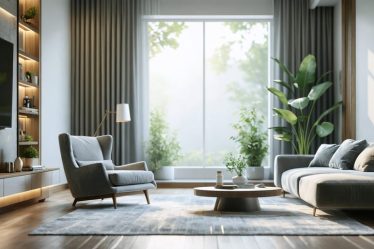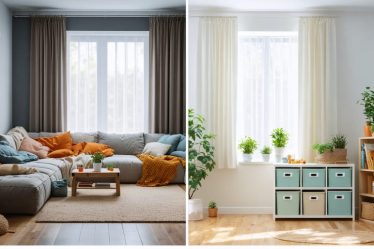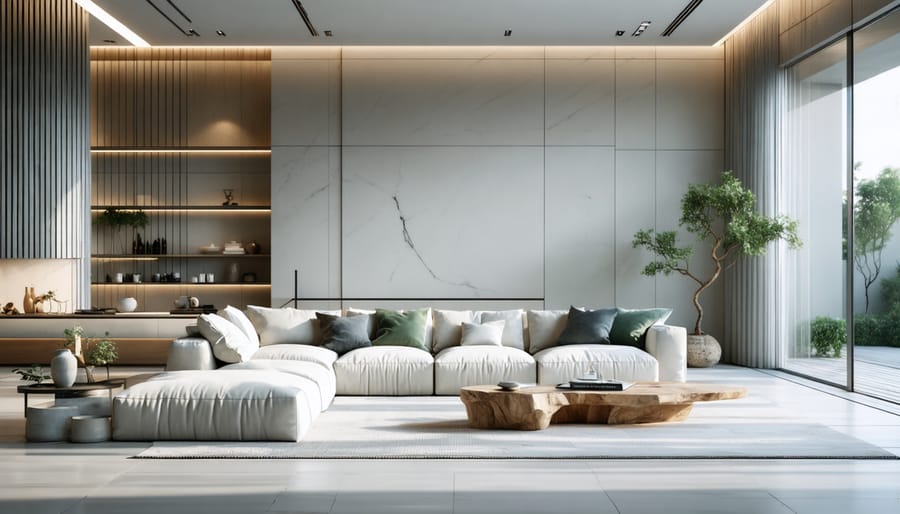
In a world of endless consumption and digital noise, embracing minimalism offers a path to genuine contentment and purpose. Living simply isn’t about deprivation – it’s about intentionally choosing what adds real value to your life while gracefully releasing what doesn’t. By thoughtfully curating our spaces, schedules, and relationships, we create room for what truly matters: meaningful experiences, deeper connections, and personal growth.
Think of minimalism as a gentle reset button for your life. It’s the art of identifying what brings you joy and purpose while letting go of the excess that clouds your vision and drains your energy. Whether you’re overwhelmed by physical clutter, digital distractions, or a packed calendar, simplifying your approach to daily living can transform chaos into clarity.
The beauty of minimal living lies in its flexibility – there’s no one-size-fits-all approach. Your version might mean a capsule wardrobe and a clutter-free home, while someone else’s could focus on digital minimalism and simplified meal planning. What matters is discovering the balance that allows you to breathe easier, think clearer, and live more authentically in alignment with your values.
Let’s explore how embracing simplicity can transform your daily experience and create space for what truly enriches your life.
The Beauty of Less: Simplifying Your Personal Care Routine
Curating Your Essential Beauty Collection
Building a minimalist beauty collection isn’t about depriving yourself of products you love; it’s about curating a thoughtful selection that truly serves your needs. Start by evaluating your current routine and identifying which products you actually use regularly. The key is to develop an effective skincare routine with multipurpose products that deliver results.
Look for items that can serve multiple functions, like a tinted moisturizer with SPF or a cream that works for both cheeks and lips. I’ve found that having fewer, high-quality products not only simplifies my morning routine but also helps me better understand what works for my skin.
Consider these essential categories:
– One gentle cleanser
– A daily moisturizer with SPF
– A versatile lip and cheek tint
– A single neutral eyeshadow palette
– One mascara
– A multi-use face palette
When selecting products, focus on those that complement your natural features and lifestyle. For example, if you’re often on the go, cream products that can be applied with fingers might be more practical than those requiring special brushes.
Remember to regularly assess your collection and be honest about what you’re actually using. It’s better to have five products you love and use daily than twenty that gather dust. As your needs change with seasons or lifestyle shifts, allow your collection to evolve mindfully.
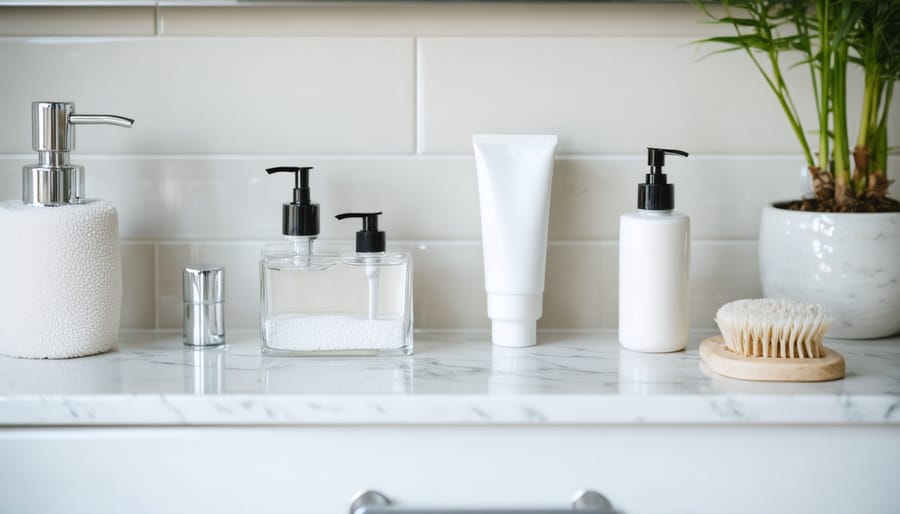
Sustainable Beauty Practices
When I first embraced minimalism, I discovered that simplifying my beauty routine not only reduced waste but also helped me feel more intentional about self-care. By adopting eco-friendly lifestyle habits, I’ve found joy in a more sustainable approach to beauty.
Start by auditing your current products. Keep only what you genuinely use and love, then commit to finishing products before buying new ones. Consider switching to multi-purpose products, like tinted moisturizers with SPF or balms that work for lips, cheeks, and cuticles.
Sustainable beauty extends beyond product choices. Opt for reusable cotton pads instead of disposable ones for makeup removal, and choose bamboo tools over plastic alternatives. Many brands now offer refillable containers or package-free options, helping reduce plastic waste while maintaining quality.
For a truly minimal routine, focus on skin health rather than covering imperfections. This might mean investing in fewer, higher-quality products that truly work for your skin type. Look for brands that use recyclable packaging and natural ingredients, but remember that sustainable beauty looks different for everyone.
Try making simple DIY treatments using kitchen ingredients like honey, yogurt, or avocado. These natural alternatives often work just as well as store-bought products and create zero waste. Remember, transitioning to sustainable beauty practices is a journey – start with small changes and build from there.
Minimalist Kitchen: Cooking with Purpose
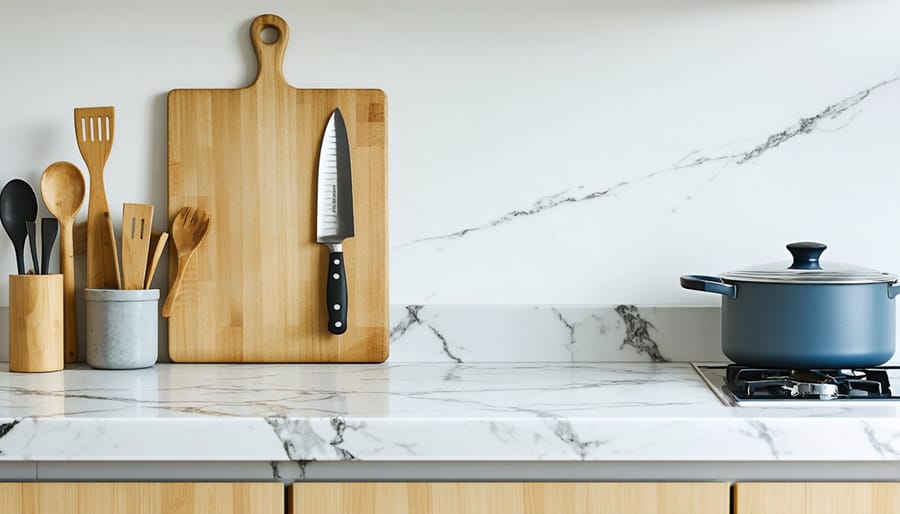
Essential Kitchen Tools
I’ve learned that a truly functional kitchen doesn’t need dozens of gadgets cluttering the countertops. After years of experimenting, I’ve narrowed down the absolute essentials that make cooking a joy while maintaining a clutter-free space.
Start with a high-quality chef’s knife – it’s the backbone of your kitchen arsenal. One good knife can replace several mediocre ones, and you’ll be amazed at how much you can accomplish with it. Pair it with a sturdy cutting board (I prefer bamboo for its sustainability and durability) and you’re already well-equipped for most prep work.
For cooking vessels, focus on versatility. A large stainless steel pot, a medium-sized saucepan, and a quality non-stick skillet will cover most of your cooking needs. Add a Dutch oven if you enjoy slow-cooking or baking bread – it’s incredibly versatile and can replace several other pots.
Essential tools include:
– A set of measuring cups and spoons
– Two wooden spoons (one for savory, one for sweet)
– A silicone spatula
– A colander
– A can opener
– A vegetable peeler
– A box grater
For mixing and preparing, you’ll need just a few good bowls in different sizes. Choose stackable ones to save cabinet space. A simple hand mixer can handle most tasks, though if you bake frequently, a stand mixer might be worth the counter space.
Remember, the key isn’t to deprive yourself but to be intentional about what you keep. Each item should serve a clear purpose and be used regularly. As you develop your cooking style, you might find you need to add or subtract from this list – and that’s perfectly fine!
Simple Meal Planning
Simplifying your kitchen routine doesn’t mean sacrificing delicious, nourishing meals. As someone who once struggled with overcomplicated meal planning, I’ve discovered that the key lies in smart, sustainable meal planning that focuses on versatile ingredients and efficient preparation.
Start by selecting 3-4 base ingredients that can work across multiple meals. Think quinoa, sweet potatoes, or chickpeas – these staples can transform into various dishes throughout the week. I love keeping a “capsule pantry” of 15-20 essential items that mix and match beautifully.
Create a weekly menu around these foundations, planning dishes that share common ingredients. For example, roasted vegetables can star in Monday’s grain bowl, Tuesday’s pasta, and Wednesday’s frittata. This approach not only reduces food waste but also simplifies your grocery shopping and prep time.
Consider adopting the “cook once, eat twice” method. When preparing dinner, make extra portions of your protein or grains to repurpose the next day. Those grilled chicken breasts from tonight’s dinner can become tomorrow’s lunch salad or wrap filling.
Keep your weekday recipes to five ingredients or less, saving more elaborate cooking for weekends when you have extra time and energy. Stock your freezer with homemade basics like marinara sauce, pesto, or soup bases that can quickly elevate simple meals.
Remember, minimal doesn’t mean boring – it’s about making thoughtful choices that maximize both nutrition and flavor while minimizing time and effort in the kitchen. By focusing on quality ingredients and smart preparation, you’ll find that simple meals can be incredibly satisfying.
Creating Your Minimalist Journey
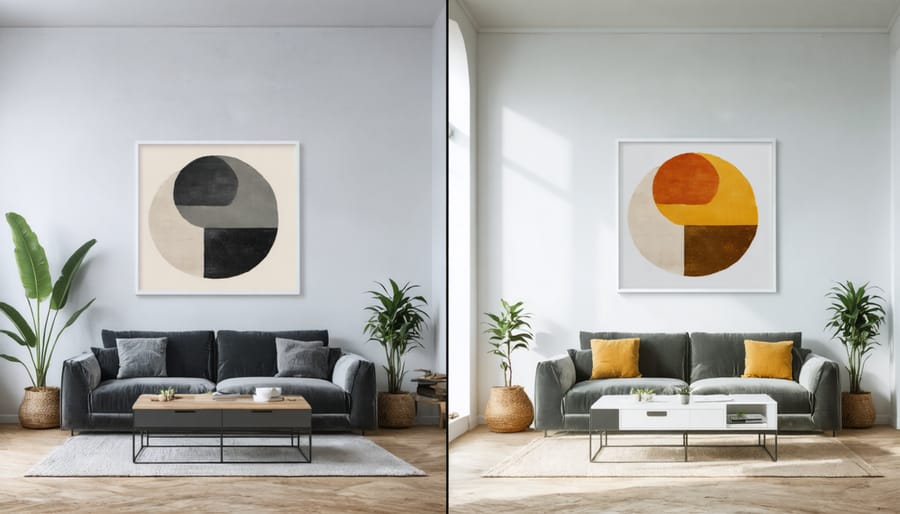
Starting Small
The journey to a simpler life doesn’t have to begin with a complete lifestyle overhaul. In fact, starting small is often the key to lasting change. I remember when I first embraced minimalism – it began with simply decluttering my bathroom counter, and that single action created a ripple effect throughout my entire home and life.
Begin by choosing one small area or habit to focus on. Maybe it’s spending five minutes each morning clearing your kitchen counter, or dedicating 15 minutes before bed to prepare for tomorrow. These tiny actions might seem insignificant, but they create powerful momentum.
Consider starting with your morning routine. Instead of reaching for your phone first thing, take a moment to sit quietly with your coffee. Or try the “one-in-one-out” rule: whenever you bring something new home, remove one similar item. This prevents clutter from slowly creeping back into your space.
Another approachable starting point is digital decluttering. Unsubscribe from one newsletter each day, or delete unused apps from your phone. These small digital choices can significantly reduce daily overwhelm and create more mental space.
Remember, simplifying your life isn’t a race. It’s perfectly okay to take baby steps – in fact, it’s often more sustainable this way. Some days, your version of living simply might just mean making your bed or choosing to cook at home instead of ordering takeout. What matters is consistency and intention, not perfection.
Start where you are, with what you have. Choose one small change that feels manageable and build from there. As these simple habits become second nature, you’ll naturally find yourself drawn to making more mindful choices in other areas of your life.
Maintaining Balance
Living simply doesn’t mean living without joy – it’s about finding the sweet spot between minimalism and personal satisfaction. The key is developing balanced lifestyle habits that feel sustainable and fulfilling.
I’ve found that setting realistic boundaries helps maintain this balance. For instance, instead of declaring “I’ll never buy new clothes,” try implementing a one-in-one-out rule. When I started my minimalist journey, this approach helped me maintain a curated wardrobe without feeling restricted.
Create designated “pause periods” before making non-essential purchases. A 48-hour waiting period can help distinguish between genuine needs and impulse desires. This simple practice has saved me countless times from accumulating items that would’ve eventually become clutter.
Consider implementing the “joy check” – a practice inspired by Marie Kondo but with a practical twist. Before removing or adding items to your life, ask yourself: “Does this serve a purpose or bring genuine joy?” Sometimes, keeping that one ‘non-minimal’ item that makes you smile is perfectly okay.
Remember that minimalism looks different for everyone. While some might thrive with a capsule wardrobe of 30 pieces, others might need more variety to feel comfortable. The goal isn’t to match someone else’s version of minimalism but to create a sustainable lifestyle that enhances your daily life.
Regularly reassess your choices and adjust as needed. As your life evolves, so will your needs and preferences. Being flexible with your approach while maintaining core minimalist principles helps create a lifestyle that’s both simple and satisfying.
Building New Habits
Building sustainable habits is like planting a garden – it takes time, patience, and consistent care to see results. Start by identifying one area of your life where you’d like to embrace minimalism. Maybe it’s your morning routine or your weekly shopping habits. The key is to start small and build momentum.
I remember when I first started my minimalist journey, I tried to overhaul everything at once and quickly felt overwhelmed. Instead, try the “one in, two out” rule: whenever you bring something new into your home, remove two items. This simple practice helps maintain balance and encourages thoughtful consumption.
Create daily rituals that support your minimalist lifestyle. Set aside 10 minutes each evening to declutter one small space, or practice mindful purchasing by waiting 24 hours before making non-essential purchases. Use technology to your advantage by setting gentle reminders for these new habits, but be careful not to let apps and notifications overwhelm your simplified routine.
Remember that building habits takes time – research suggests anywhere from 21 to 66 days for a new behavior to become automatic. Be patient with yourself and celebrate small wins. The goal isn’t perfection but progress toward a more intentional way of living.
Think of these new habits as stepping stones rather than giant leaps. Each small change builds upon the last, creating a sustainable foundation for your minimalist lifestyle.
Embarking on a minimalist journey isn’t about depriving yourself or following strict rules – it’s about creating space for what truly matters in your life. As we’ve explored throughout this article, living simply can transform not just your physical space, but your mental wellbeing and daily experiences as well.
Remember that your minimalist path is uniquely yours. Start small – perhaps by decluttering one drawer or simplifying your morning routine. Notice how each small change brings a sense of lightness and clarity to your day. Many women in our community have shared how these simple shifts have led to reduced stress, more time for self-care, and deeper connections with loved ones.
The beauty of minimalism lies in its flexibility. Whether you’re drawn to a capsule wardrobe, streamlined skincare routine, or simplified meal planning, choose the areas that resonate most with your lifestyle and values. Don’t feel pressured to transform everything overnight – sustainable change happens gradually.
As you move forward, keep checking in with yourself: Does this item, habit, or commitment add value to my life? Does it align with my priorities? Let these questions guide your choices as you create a life with more intention and less overwhelm.
Ready to begin? Take that first step today, knowing that every small action brings you closer to the peaceful, purposeful life you envision. Your journey to simple living starts now.


